Watching "Sundown," the premiere episode of Misha Green's new series Lovecraft Country (HBO), I found myself thinking of the opening of H.P. Lovecraft's "The Call of Cthulhu," the first of his stories about the monstrous Old Ones who once ruled the Earth (and slumber beneath it still). "The most merciful thing in the world, I think, is the inability of the human mind to correlate all its contents," Lovecraft says:
"We live on a placid island of ignorance in the midst of black seas of infinity, and it was not meant that we should voyage far. The sciences, each straining in its own direction, have hitherto harmed us little; but some day the piecing together of dissociated knowledge will open up such terrifying vistas of reality, and of our frightful position therein, that we shall either go mad from the revelation or flee from the light into the peace and safety of a new dark age."
It is a recurring theme in the works of H.P. Lovecraft (1890–1937) that the horrible truth of the world—of the evil that lies beneath it, and of the insignificance of our place within it—would drive any person mad who glimpsed it whole. (Inquisitive characters in Lovecraft tales are frequently driven insane, or outright destroyed, by mere fragments of the arcane truths that they unearth.) As Stephen King has written, the best of Lovecraft's stories "make us feel the size of the universe we hang suspended in, and suggest shadowy forces that could destroy us all if they so much as grunted in their sleep."1 It is only our inability to see and understand the full nature of reality—our blissful, "merciful" ignorance—that lets us retain our sanity and go on living.
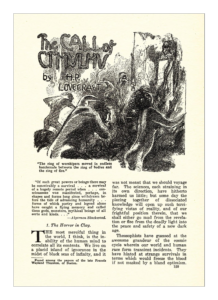
Though uncelebrated in his short lifetime—earning a pittance with his macabre tales published in such pulp magazines as Weird Tales and Astounding Stories—Lovecraft is now remembered as a visionary influence in horror, one who is (in the words of critic Michael Dirda) "second only to Edgar Allan Poe in the annals of American supernatural literature." (Few writers are so uniquely seminal that their names become adjectives, but—much like "Kafkaesque"—the term "Lovecraftian" is likely to be at least vaguely familiar even to people who have never read a word of Lovecraft.)
Lovecraft was also, of course, an intellectual snob, an Anglophilic classist, and a galloping, thundering racist. He wrote poetry openly extolling white supremacist beliefs, including one entitled "On the Creation of N–––––s,” which posits that the Gods created Black people as an intermediary creature between animals and (white) men. ("A beast they wrought, in semi-human figure/Filled it with vice, and called the thing a N–––––.") He openly admired Hitler, and his letters are full of fantasies of underground Jewish conspiracies bent on undermining the Aryan race. And his more famous esoteric pulp fictions about lurking horrors are saturated with his racist beliefs, and can be read as a conscious or unconscious expression of what we would now call white fragility, the abject terror of a white colonialist civilization barely keeping its own inevitable destruction at bay.
If the intellectual white man represents sanity and civilization for Lovecraft, the enemy at the gates are (primarily) giant alien demons, and (secondarily) everyone else. In "Lovecraft Country" (largely fictional towns in northeastern Massachusetts), the woods teem with animalistic cults of Black and foreign miscreants who worship a primordial evil and surrender to its degenerate ways. In "The Call of Cthulhu," for example, a group of white policemen come across a "voodoo orgy" of "nearly a hundred mongrel celebrants" worshipping the sleeping alien god Cthulhu, surrounded by the "oddly marred bodies" of women and children. Lovecraft writes: "Animal fury and orgiastic license here whipped themselves to daemoniac heights by howls and squawking ecstasies that tore and reverberated through those nighted woods like pestilential tempests from the gulfs of hell." (The police, repulsed, slaughter half of the cult, and take the rest prisoner, discovering them to be "Negroes and mulattoes," and "men of a very low, mixed-blooded, and mentally aberrant type." Only a handful are found to be "sane enough to be hanged.")
Some of Lovecraft's defenders have attempted to separate the author's deeply troubling personal and political beliefs from his wildly influential horror mythos. But it is difficult not to read the latter as—at least partially—a primal expression of the former. As Wes House writes:
"The admixture of [Lovecraft's] maniacal bigotry and hysterical racism ignite stories of nihilism often based on the master-race ideology […] Lovecraft was a writer who breathed life into the reactionary anxieties and racist horrors of shifting social and global paradigms, including those of 'race relations,' war, revolution, and class struggle. He was not only the 'modern pope of horror' but also its grand wizard."
I am, for the record, very far from being a Lovecraft aficionado, let alone a scholar, and I won't pretend to be either. (In all honesty—even leaving aside his abhorrent beliefs—I find the man's prose almost literally impossible to read.) Nor have I read the source material for this new adaptation, Matt Ruff's 2016 novel Lovecraft Country, which first explored the racial injustices of the Jim Crow era through a Lovecraftian lens (or vice versa?). I know nothing more, that is to say, than the average first-time viewer about where this is all going, or how either Ruff or Green heard this horror mythology speaking to, or through, our own horrifying history.
But I come back to that quote from "The Call of Cthulhu" with which I began, and the notion that the only thing keeping us from insanity is our inability to see the truth of the world as a whole. That resonates, for me, when I think about the two very different narratives that Lovecraft Country is attempting to splice here. For if there is an ancient evil slumbering just beneath the surface of America, it is surely this country's legacy of racism. Lovecraft may have seen white supremacy as a civilizing bulwark barely containing the menacing tide of evil, but the truth is that this repellent philosophy itself is America's original sin, our primordial evil, present and pervasive and formative since the founding. White supremacy has shaped every aspect of American life: It has cleared our fields, and paved our roads, and built our institutions, and all the blood spilled in its name saturates the very soil in which all our bounties grow.
Racism, that is to say, is America's Old God, and it has spawned a pantheon of horrors that even the most aware of us struggle to comprehend fully and tremble to confront directly. As in one of Lovecraft's tales, this demon has largely been purged from our history books and memories, but we know it is there: Like a Lovecraftian hero, we've sensed its dreadful influence disturbing our dreams; we've felt its snaking tendrils encircling our lives; and we have seen it, all too often, erupt into monstrosity. But this knowledge is terrible—the scope and scale of it almost beyond our comprehension—and so we take mental refuge on that "placid island of ignorance," in order to live our lives, maintain our illusions, and retain our precarious sanity.
But we know we can't escape it. We dread its full awakening. We fear its dangerous wrath, and we tremble when we imagine its terrible judgement. We know that it will claim too many of us, and poison the souls of too many more. We know that, at best, we can drag it occasionally into the light, and drive it temporarily back underground, and perhaps earn ourselves a brief and imperfect reprieve. We know that it is always waiting, always dangerous, and that it will never, ever go away.
Welcome to Lovecraft Country. If it seems familiar, that's because it's the place we've lived all along.
"But more than that, it is the story of an American boy, and a dream that is truly American.”
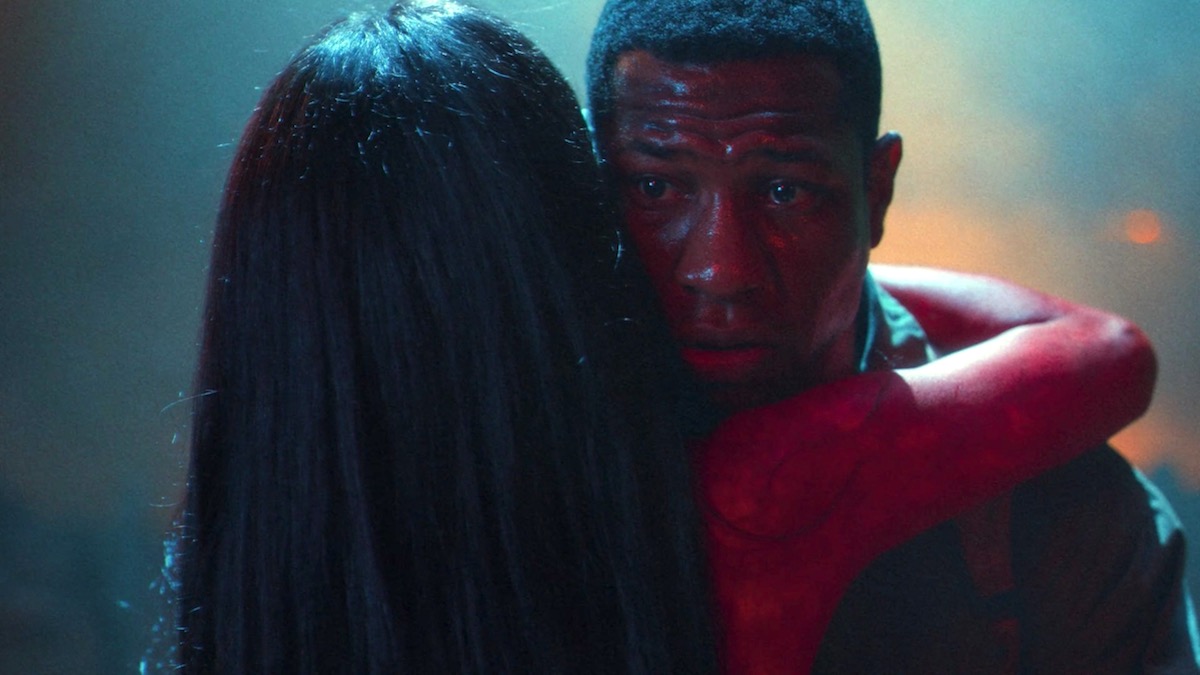
All of this, then, suggests that Lovecraft Country may turn out to be something of a sister-series—at least in its aspirations—to its network sibling Watchmen. Damon Lindelof's 2019 series repurposed the language of comic books to explore overlooked intertexts of white supremacy in the American narrative, and now Misha Green appears to be using the tropes and trappings of pulp fiction—that most American of literary genres—for related purposes.
Green has previously ventured forth to the places where serious subjects meet genre conventions, and she has brought back treasures. The last series she created was the criminally under-seen Underground (WGN), which used this country's long period of African-American enslavement as a suitable setting for genre fiction. We are accustomed to very solemn, very sombre, very heavy narratives of slavery, in which Black people are long suffering martyrs, and white people are either saintly saviors or cartoonish villains. But Underground reclaimed this period of American history as a time of Black heroes, and delivered two seasons of a series that gloriously expanded the possibilities of the "slavery movie." Sometimes a thrilling heist story, sometimes a harrowing action-adventure series, sometimes a poignant love story, Underground exploded the narrative possibilities of its subject, and dared to tell stories that were exciting, empowering, and—not infrequently—fun. The effect could be a little disorienting—Are we supposed to be enjoying a slavery story this much?—but it was a surprisingly simple approach to an overworked genre. By simply treating its subject as a vehicle for great storytelling, and by centering fully developed Black characters with actual agency, Underground felt fresh, invigorating, and somehow revolutionary.
And, on the evidence of "Sundown"—written by Green, and directed by Yann Demange—Lovecraft Country is working in a similar frequency here: approaching a shameful and sensitive topic (now Jim Crow-era America) with a pulp fiction sensibility. The opening of "Sundown" announces its genre-merging ambitions in no uncertain terms, as we open with a stunning dream sequence that is a playful and poignant masterpiece of stylistic, thematic, and narrative layering.
I think it's worth spending a few minutes on this overture to Lovecraft Country, if only to appreciate how all the various instruments in Green's pop-culture symphony harmonize together.
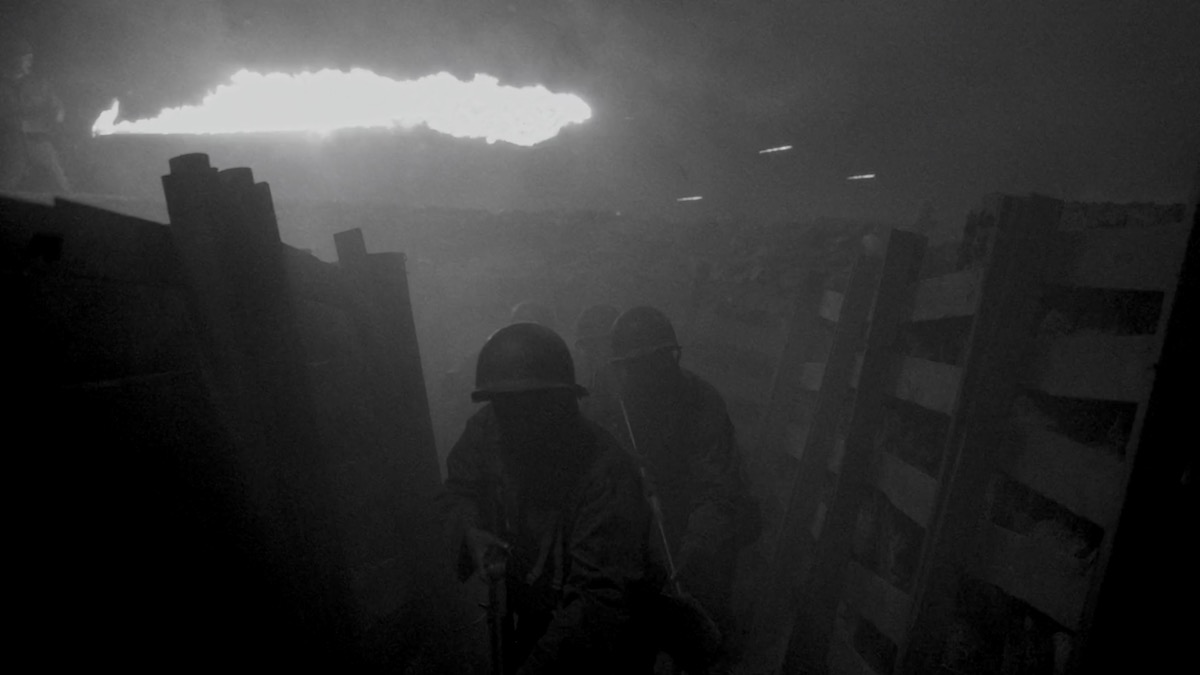
Even before images fill the screen, we hear the opening flourish of an old-school Hollywood movie, and so we are not surprised to fade in on a grainy black-and-white film, the trumpets of the musical intro now merging with the familiar sounds of a war picture. (We also see fire shooting from offscreen, and if you're like me you thought Godzilla before you thought flamethrowers.) The black-and-white cinematography, combined with the orchestral music, screams mid-century studio picture—but we quickly realize this interpretation is at odds with the combat depicted. This is not the glorified, antiseptic screen-action of the era, but combat that is chaotic, bloody, and cruelly violent. So the style says Hollywood fantasy of heroic American soldiers, but the substance says that fantasy has been tainted by a much uglier reality.
And in this dream, as the Hollywood fantasy shatters, we get our first look at Atticus "Tic" Freeman (Jonathan Majors), looking terrified. A falling bomb bursts the narrative into full-color, and Tic makes an instinctive decision to leap out of the trench, to leave behind that particular, unsustainable fantasy. He runs for a few moments through reality, firing his weapon at enemy soldiers offscreen, before plunging into a better way to escape reality: pulp fiction.
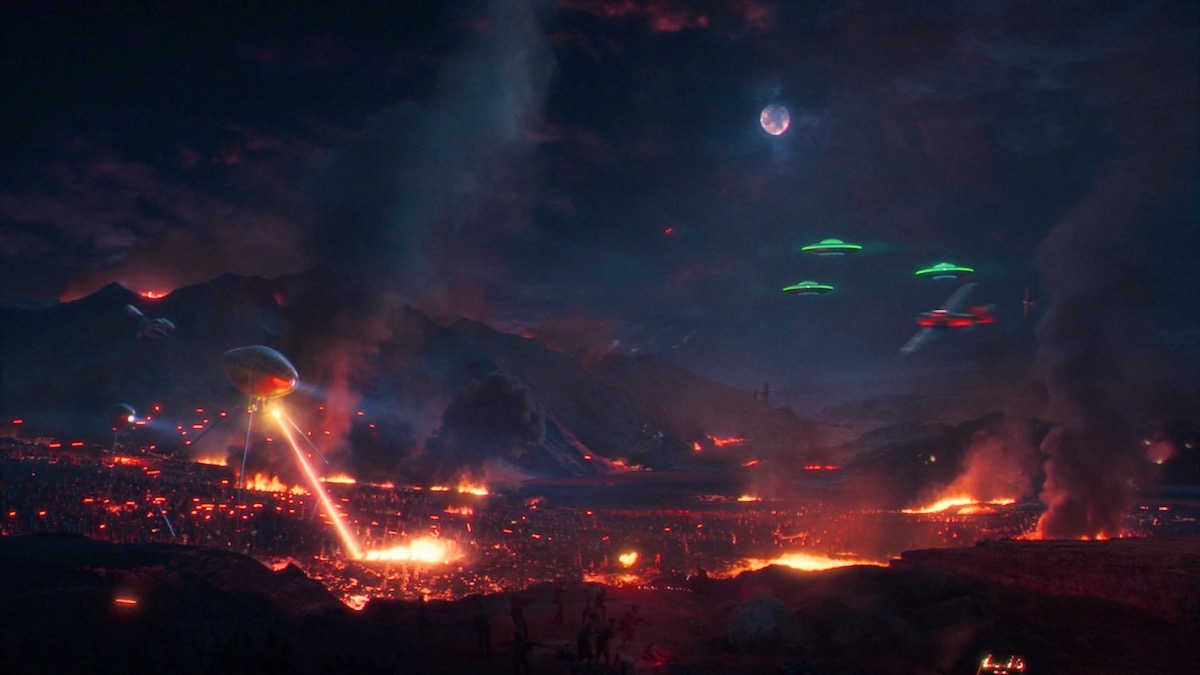
The scene before him—saturated with colors, and replete with fighter planes, UFOs, War of the Worlds-type tripods, and flying monsters—is like the cover of an issue of Weird Tales or Astounding Stories brought to life. The battles rage around Tic—aliens, monsters, and soldiers from various points in history all clashing—but Tic no longer looks scared so much as awestruck. He stands gazing in wonder as a beautiful, scantily clad, red-skinned woman (Jamie Chung)—a Princess of Mars—descends from a flying saucer in a beam of light, and he walks in a daze into her arms. It is not a sexual embrace: She seems, in fact, to be comforting him.
While all this has been happening, Green has layered yet another narrative atop it. The music from the motion picture we heard on the soundtrack gives way, first to dialogue, then to narration. We hear white men taunting someone: "Where you going, Black boy?" We hear the year the story begins, 1928. (This is the same year Lovecraft published his first Cthulhu story, incidentally.) Then the narrator tells us that "This is the story of a boy and his dream. But more than that, it is the story of an American boy, and a dream that is truly American." And we realize, amidst the chaos, that what we are hearing is The Jackie Robinson Story (1950), starring none other than Jackie Robinson.
Pulp fiction, movies, and baseball: What could be more quintessentially American? These are innocent, escapist narratives of Americana being layered together as Atticus tries to retreat from the horrors of reality. But they're all flawed narratives, aren't they? ("Stories are like people," Tic will say later. "Loving them don't make them perfect. You just try to cherish them, and overlook their flaws.")
The war movies are not perfect: They make American imperialism seem noble, make war itself seem romantic, and lure young black men to die for a country that refuses to treat them as citizens. (Later in the episode, we will hear about how Tic fought with his father over his military service, and we will also see Tic glance askew at a recruitment officer luring still more young black men into the army.)
The pulp fictions are not perfect: They are largely colonialist tales, rife with attitudes of white supremacy. The alien woman here is a Red Martian from Edgar Rice Burroughs' A Princess of Mars, which Tic fell asleep reading to have this dream. Burroughs—who also created Tarzan—was another pulp writer of colonialist fantasies full of racial stereotypes. (It may be worth mentioning that a complex, color-based caste system exists on Burroughs' Mars, in which Red Martians—descended from an even purer race of White Martians—are the dominant ruling class, and Green Martians are morally and intellectually inferior savages. And, as mentioned later in the episode, the hero of Burroughs' Mars books, John Carter, was a Confederate officer. "He fought for slavery," as Tic's fellow traveller Maybelle [Shanesia Davis] says. "You don't get to put an 'ex-' in front of that.")
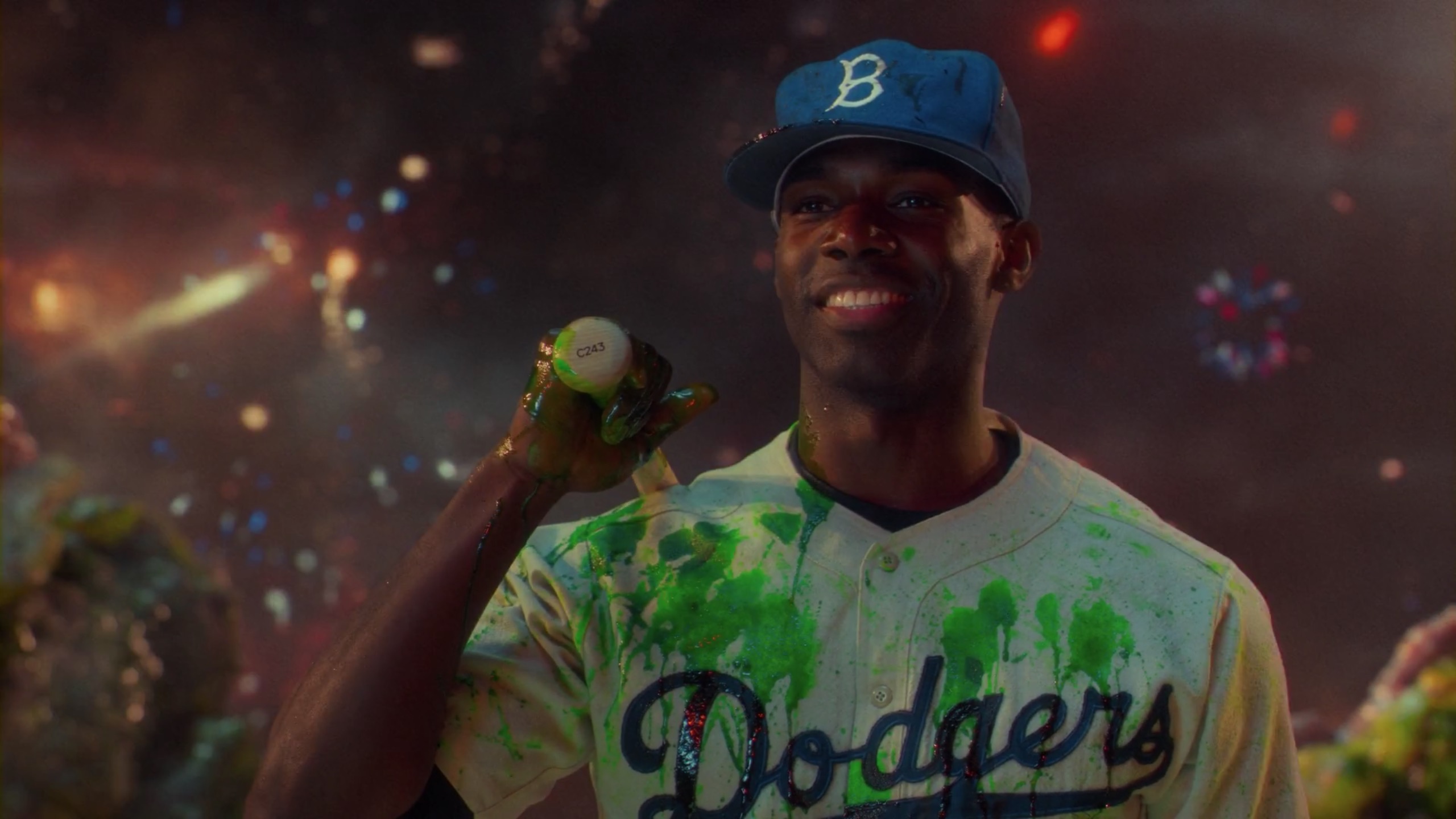
And then there's baseball, "America's pastime." The Jackie Robinson Story is a relatively accurate but typically sanitized Hollywood biopic, a feel-good B-picture about what a great thing it is that Jackie Robinson broke the color barrier in baseball. An American boy with an American dream, the earnest narrator says, but we know that the real story—of racism in baseball, and racism in America—is so much uglier and more complicated than Hollywood could ever acknowledge. Jackie Robinson was a hero, but The Jackie Robinson Story is an example of how white America tells itself comforting fairy tales about its own racism, cleaning the stories up so they can be added to all our other self-serving illusions about "progress" and "the land of opportunity."
And so of course Jackie Robinson (Robert Hamilton) himself appears in Tic's dream. As Tic takes comfort in the arms of his Martian princess, she hisses a warning to him in her alien tongue, and America's primordial evil unfurls itself behind them. Jackie suddenly appears to destroy the monster—it explodes into green goo with a single swing of his mighty bat—and the sky erupts in celebratory red, white, and blue fireworks. But, almost immediately, the monster regroups, reforms, and attacks again, opening wide its gaping maw.
The symbolism is obvious, but no less effective: You can strike blows against it, as Jackie did, but not even good old #42—"The Dark Destroyer"—can kill America's demon forever. It will always be there.
The dream is almost over, but Green still isn't done layering in signifiers. Just before Tic is jolted awake, the soundtrack shifts from movies to music, as we hear the opening strains of the 1954 song "Sh-Boom," one of the first rock-and-roll songs to become a Billboard hit. Importantly, the version we hear is not the original, written and performed by the all-Black group The Chords, which reached #2 on the pop charts. What we hear is the cover version that reached #1 just a few months later, by the all-white quartet The Crew-Cuts. (Guess which group Ed Sullivan would invite to perform the song on national television that year?)
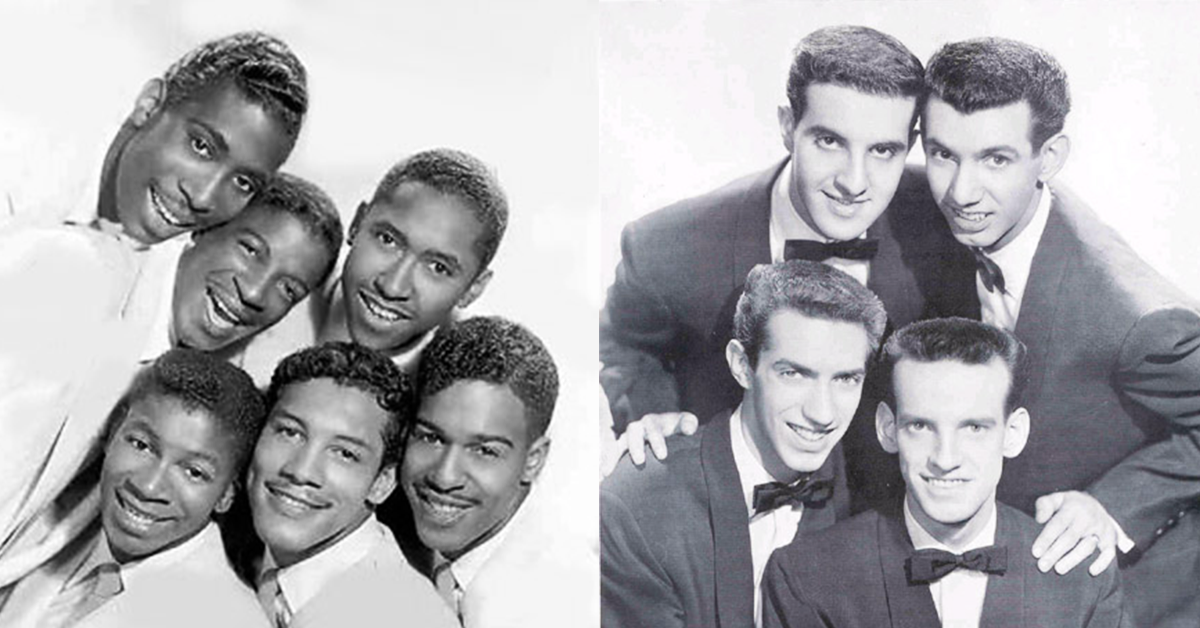
So if "Sh-Boom" represents the birth of mainstream rock-and-roll, it also represents the moment rock-and-roll—a musical form rooted in Black traditions—began to be appropriated by white people. (We hear another reminder of that later in the episode, as Ruby and Leti sing "Whole Lotta Shakin' Goin' On," first recorded in 1955 by black R&B singer Big Maybelle—note the name—but which became a mainstream hit for white singer Jerry Lee Lewis two years later.)
Life would be a dream, indeed.
This entire dream sequence is a bravura opening: visually inventive, narratively complex, thematically resonant, emotionally evocative, and—not least importantly—fun. It announces Lovecraft Country's intention of simultaneously trafficking in various escapist "American dreams," exploring their problematic foundations, challenging the self-serving illusions they offer, and perhaps repurposing their tropes into something both entertaining and empowering.
That's an ambitious project, and one that will require walking several very tricky lines in terms of tone. I am, on the basis of "Sundown," still nervous about how well Lovecraft Country can navigate its various streams, but it is impossible not to be excited by the undertaking.
"Finally made it to the Promised Land."

Between last year's Watchmen and this year's Lovecraft Country, HBO seems determined to be the network that uses genre fiction as a Trojan horse to teach America about its own history. The first act of "Sundown" is the story of Tic's return home, but it is also the story, in microcosm, of "The Great Migration." The half-century following the First World War saw roughly six million African-Americans leave behind rural life in the former Confederate states to start over in urban centers of the midwest, west, and northeast. As Langston Hughes wrote in his poem "One-Way Ticket":
I pick up my life
And take it with me
And I put it down in
Chicago, Detroit,
Buffalo, Scranton,
Any place that is North and East—
And not Dixie.
Here, we only see Tic cross one state-line—from Kentucky to Illinois—but that psychic journey is representative of a much larger one: He begins in the wide-open fields of Kentucky, and ends up on the South Side of Chicago. "Finally made it to the Promised Land," says the older woman on the bus, Maybelle, when they cross the bridge (named for a slave owner) into Illinois and out of the old Confederacy. "Good riddance to Old Jim Crow," Tic agrees, flipping off what they've (supposedly) left behind.
We do not yet know much about the Freeman family history, but Tic was almost certainly born in Chicago because his parents or grandparents made some version of this same journey. Of course, as Lovecraft Country will explore, there was (and is) no racism-free "promised land" in America. (We are reminded of this truth very quickly: When the bus breaks down, Tic and Maybelle know without having to say a word that they are not welcome on the truck that shows up to carry all the white passengers to the next town.) And in fact, the influx of large numbers of black citizens into predominantly white towns during the Great Migration exposed, entrenched, and exacerbated prejudices in the North (as we see in the "Sundown Towns" later in the episode).
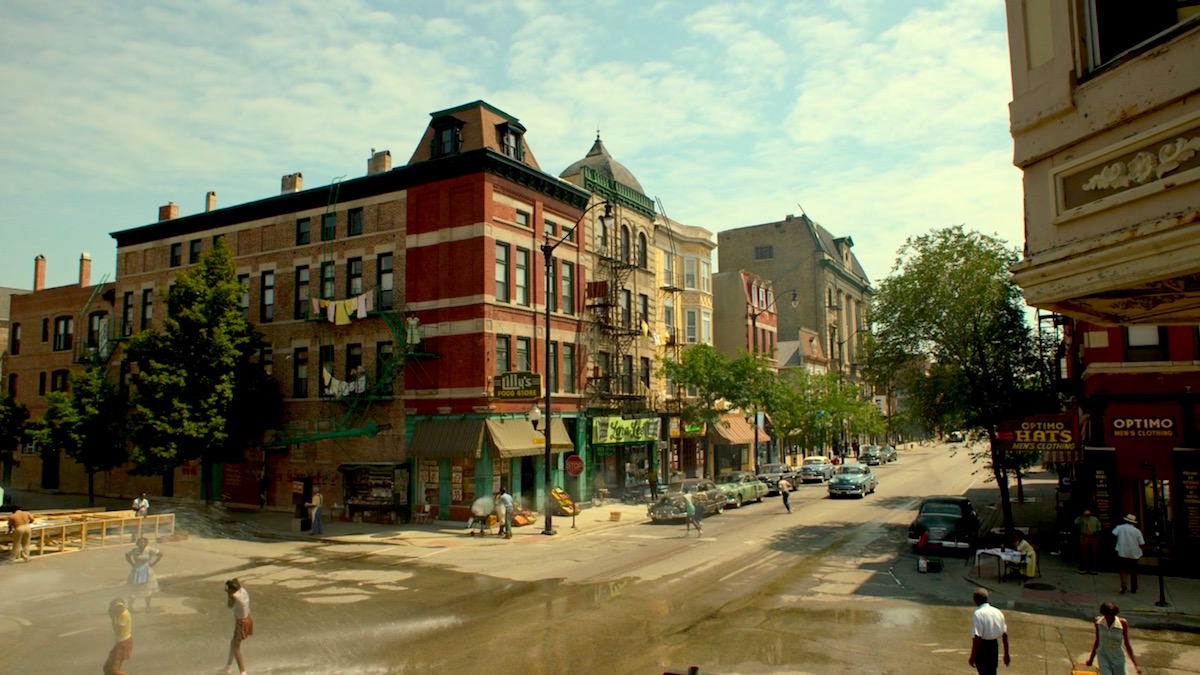
But as Lovecraft Country reminds us of the hostility and danger of white communities around the country, it also takes time to celebrate the black communities carved out during the Great Migration. At the turn of the previous century, fewer than 2 percent of Chicagoans had been Black; by 1970, however, over a million African Americans—roughly a third of the city's population—were living in Chicago, mostly on the city's South Side. (As evidenced by the 1919 Chicago Riots—set off after white men drowned a Black teenager for swimming over the wrong invisible line off the 29th Street Beach—the city was never a "promised land." Though Chicago did not have blatant Jim Crow laws on the books, redlining and restrictive housing covenants kept the majority of black residents confined to the part of town known as "the Black Belt" or "Bronzeville," ensuring that it was—as it remains today—one of the most segregated cities in America.)
All of which makes the depiction of Bronzeville in the first half of "Sundown"—with its black-owned businesses, and its joyous block parties—that much more glorious and poignant. It would be dangerous to romanticize these neighborhoods too much—they remain, to this day, systemically disenfranchised, disproportionately poor, and overly policed—but Lovecraft Country presents these few square blocks as a Black oasis in the center of America. The only freedom and happiness we see these characters enjoy is here, and so "Sundown" spends a lot of time lovingly establishing this community in order to contrast it with the rest of America later. Once our characters leave this safe space, where they are free to work and play and love and be themselves, they will be prey to the monsters Tic's cousin Dee (Jada Harris) draws in her father's road atlas.
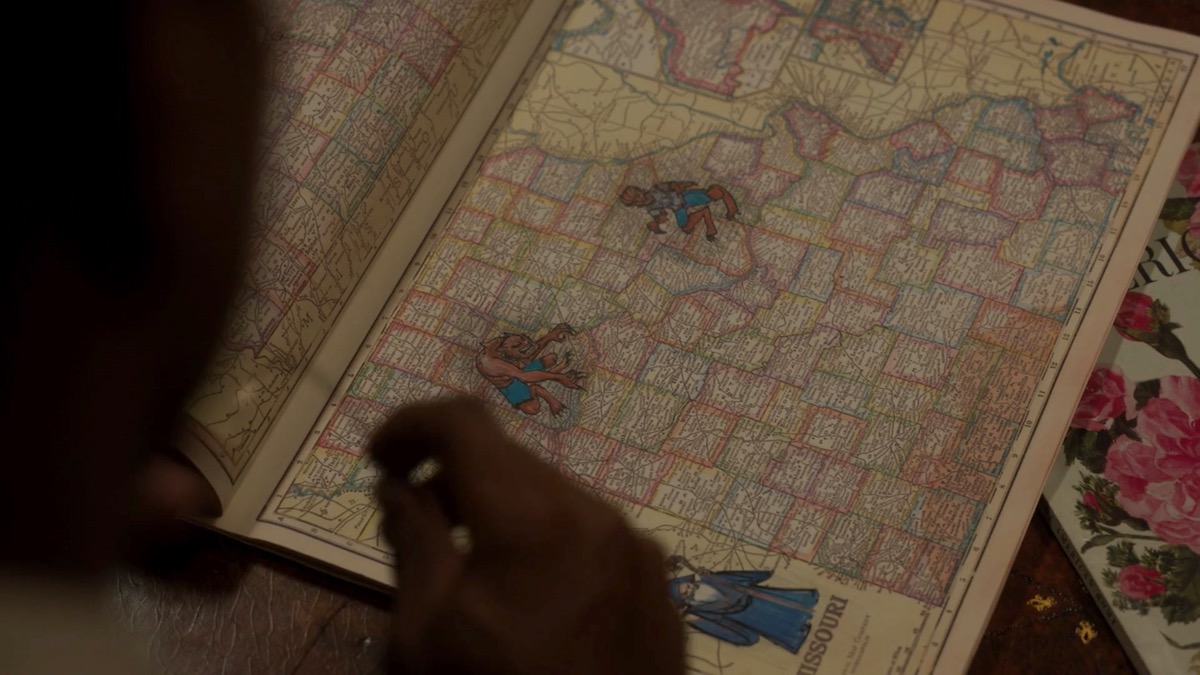
Mapping these dangers—and identifying the tiny safe spaces within them—is the business of Tic's uncle George (Courtney B. Vance), who publishes the Safe Negro Travel guidebook, a fictionalized version of real-life guides for Black travelers like The Negro Motorist Green-Book. And when Tic decides to set off for Massachusetts in search of his father Montrose (a yet-unseen Michael K. Williams)—who has written Tic a cryptic letter about finding his birthright there—George and their young friend Leti (Jurnee Smollett) decide to join him on this cross-country trip through troll-infested America.
Which is to say, they are leaving their home, leaving their community, and leaving behind the relative safety of "normal life." In terms of the hero's journey, they are venturing forth from the ordinary world into the extraordinary, where they will face dangers. In horror tropes, they are leaving behind their well-lit homes—their safe spaces—and journeying to the haunted house, the evil castle, the monster-populated forest, the cabin in the woods. They are venturing into the uncertain waters that are the rest of America, and there—as the old maps said—be dragons.
"That is, it depends on assumptions which we hold so deeply so as to be scarcely aware of them."
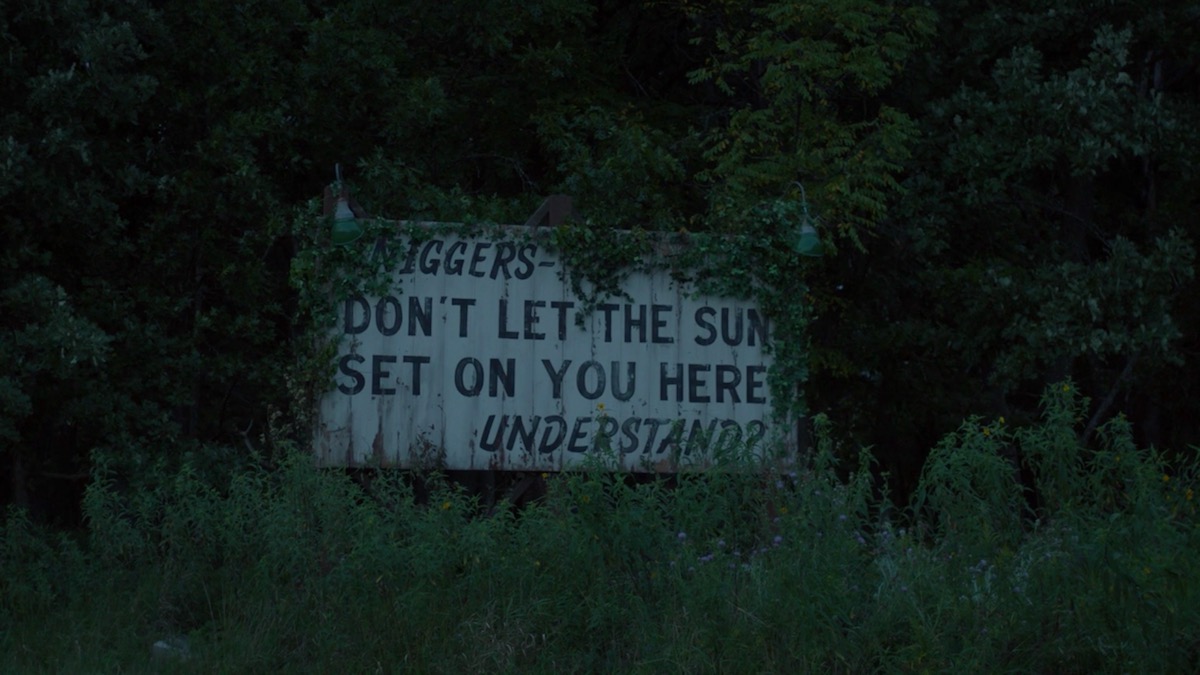
There is a strong dividing line between the first half of "Sundown" and the second half, a stark distinction of tone and tenor that is—as I suggested Misha Green's work can be—a little jarring. The textured authenticity of the first half, set on Chicago's South Side, gives way to something else in the second half, in a way I'm not yet sure completely works for me. (I think it does—or I think, at least, I understand it—but it's going to require us to do some processing here.)
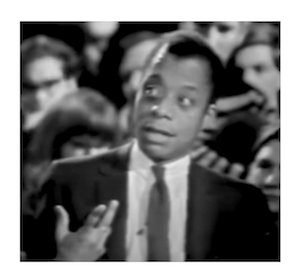
Before we get to that, however, let's talk about the dividing line itself. It comes just as the trio sets off on their journey, at almost exactly the 30-minute mark, and it's one of the best sequences I've seen in a while. As a title card tells us we are leaving Chicago for the "Midwest," we hear the unmistakable voice of James Baldwin, and the opening words of his 1965 debate with William F. Buckley at the Cambridge Union. The motion on the floor? "The American Dream is at the Expense of the American Negro.”
It is worth, I think, quoting what we hear of Baldwin's opening statement in full:
Good evening,
I find myself, not for the first time, in the position of a kind of Jeremiah. For example, I don’t disagree with Mr. Burford that the inequality suffered by the American Negro population of the United States has hindered the American dream. Indeed, it has. I quarrel with some other things he has to say. The other, deeper, element of a certain awkwardness I feel has to do with one’s point of view—I have to put it that way—one’s sense, one’s system of reality. It would seem to me the proposition before the House, and I would put it that way—Is the American Dream at the expense of the American Negro, or the American Dream is at the expense of the American Negro—is a question hideously loaded. And that one’s response to that question—one’s reaction to that question—has to depend on, in effect, where you find yourself in the world, what your sense of reality is, what your system of reality is. That is, it depends on assumptions which we hold so deeply as to be scarcely aware of them.
A white South African, or a Mississippi sharecropper, or Mississippi sheriff, or a Frenchman driven out of Algeria, all have, at bottom, a system of reality which compels them to, for example, in the case of the French exile from Algeria, to offend French reasons for having ruled Algeria. The Mississippi or Alabama sheriff, who really does believe, when he’s facing a Negro boy or girl, that this woman, this man, this child must be insane to attack the system to which he owes his entire identity. And on the other hand—
I am mostly going to resist, for now, the urge to discuss Baldwin's famous and powerful debate performance in full, in part because I could spend 10,000 words on it alone—Seriously, go watch it—and in part because I am not sure we won't hear more of it as Lovecraft Country proceeds. (Here, it cuts off mid-sentence, implying that Green might return to it in later episodes.) There is much in it that is relevant, not only to the larger subject of race relations in America (a subject on which Baldwin was, and remains, a thinker of unparalleled eloquence), but also to some of the specific subjects Lovecraft Country is tackling in its pastiche of fictions, in its centering of Black heroes in traditionally white adventure genres where they have more often been framed as the villains. ("It comes as a great shock," Baldwin will go on to say shortly, "to discover that Gary Cooper killing off the Indians, when you were rooting for Gary Cooper, that the Indians were you.")
But for now let's just focus on the fact that this section of Baldwin's speech is about "point of view": He is speaking about how, for Black and white people alike, it all comes down to "where you find yourself in the world, what your sense of reality is, what your system of reality is."
And this is why I describe this extraordinary montage as the dividing line in "Sundown." Because the rest of the episode, from this point forward, will require us—and I am speaking here particularly of those of us who are white—to radically adjust our senses of reality. It is difficult—even for what Baldwin called the "relatively conscious whites"—to see America as the full-blown horror environment Lovecraft Country depicts as Tic, George, and Leti get further and further away from the comparative warmth and safety of Bronzeville. We resist it: Our system of reality barely permits it, for that truth is the unspeakable Lovecraftian evil that lurks beneath every aspect of American life, the one that is almost too large and frightening for us to comprehend.
We'll talk more about that a little further down, but this sequence is a transitional one, designed to ease us into that necessary adjustment. And it does so through another careful layering of words and images. We have Baldwin's voice, explaining (to an almost entirely white and privileged crowd) how a white Mississippi sharecropper, or a white Mississippi sheriff, has a sense of reality and a sense of identity rooted in a system that was built entirely to accommodate him. And the same is true of Black Americans: Their sense of reality is formed by a system entirely designed to oppress and exclude them. ("It comes as a great shock," Baldwin will go on to say of growing up Black in America, "to discover that the country which is your birthplace, and to which you owe your life and your identity, has not, in its whole system of reality, evolved any place for you.")

So Green and Demange show us these two parallel and incompatible realities in this transitional section, by tapping once again into imagery of Americana. Now, however, instead of flying saucers and baseball heroes, we see images of mid-century America. We see our protagonists driving their 1948 Packard Sedan "Woody" down the wide-open highways—an image as purely American as apple pie—but we also see the billboards saying "N–––––s, don't let the sun set on you here, understand?" We see Tic and Leti laughing over a Coca-Cola at a gas station, like a couple of teen-agers on a date, but we also see the white youths who laugh and taunt them with grotesquely racist insults. We see the small-town America of the '50s—the one still idealized by this country's conservative wing—but we see it now through the extraordinary eye of the great Black photographer Gordon Parks, who documented the beauty and dignity of Black Americans navigating the constant ugliness and indignities of a viciously segregated society.
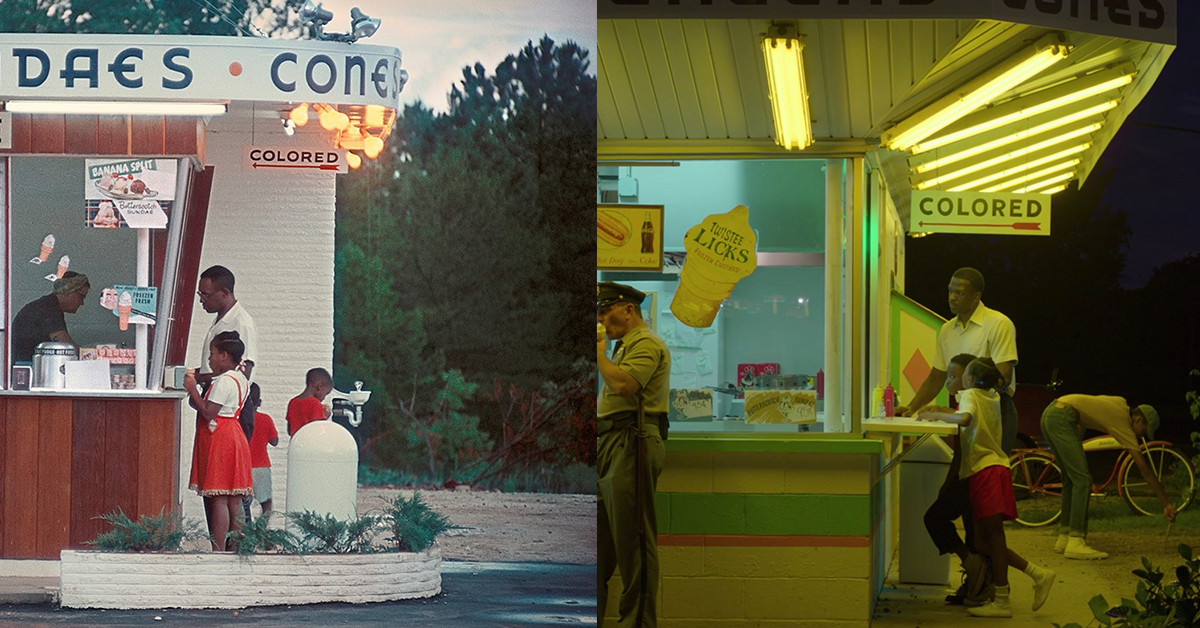
The effect is perhaps best summarized by the episode's recreation of Margaret Bourke White's iconic 1937 photo "The Louisville Flood," which captured the irony of the two realities—the two different "senses of reality"—in America. The happy white family enjoying the world's highest standard of living is one reality; the black flood victims lined up for relief (in the photo), and the black workers lined up at the bus stop to travel to menial jobs (in the recreation) is a completely different reality.
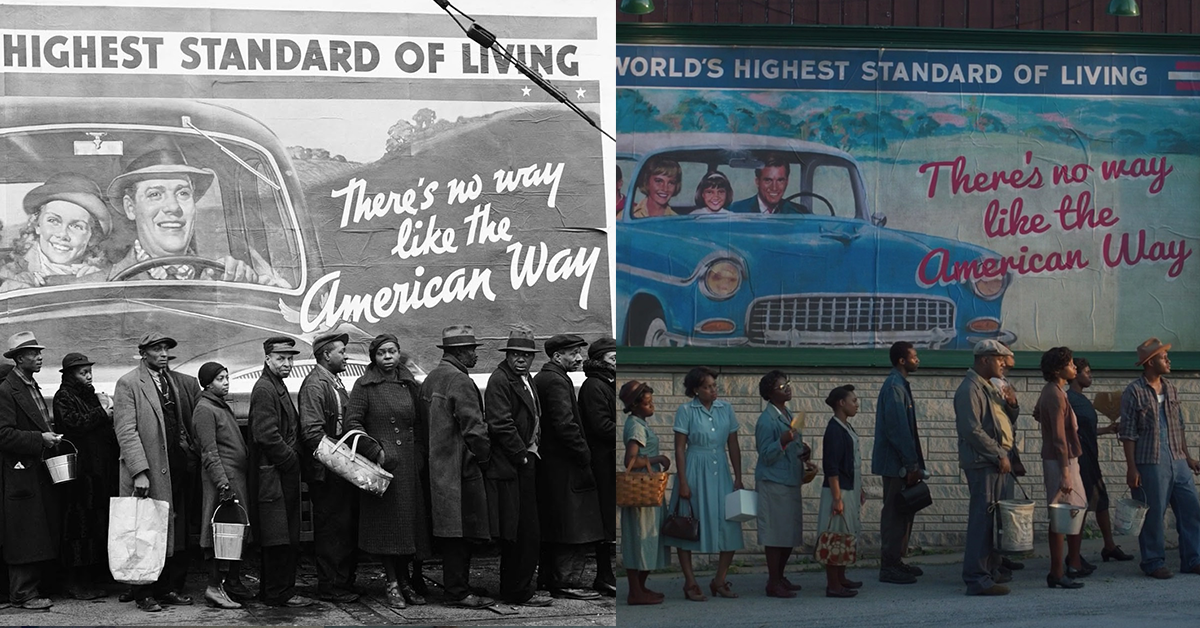
And the second is more than a powerful counter-narrative to the first (though it is certainly that): We are charged to understand the causal relationship between the two, and how—to return to the topic of the debate that overlays these images—"the American dream is at the expense of the American Negro." That the happiness and prosperity and very sense of identity of the white family relies fundamentally on the misery and disenfranchisement of the Black people. Seen through these eyes, the ideal of American prosperity—the one so many white Americans still cling to as the "real" America—becomes just another lurid pulp fiction, a self-aggrandizing fantasy rooted in (and reliant upon) white supremacy.
So, as Baldwin says, our reaction to the overall question—and our reaction to the overally project of Lovecraft Country—depends largely on where we find ourselves in the world, and on assumptions we may hold so deeply so as to be scarcely aware of them. And I am dwelling on this here not because I expect to say anything new or profound about America's foundational racial inequality. (Let me be clear, I don't.) But, simply speaking as a white critic attempting to engage with this series, it is already apparent that my willingness to challenge my own assumptions and preconceptions is going to determine a great deal about how well Lovecraft Country works for me.
"Remind me why the White House is white?"
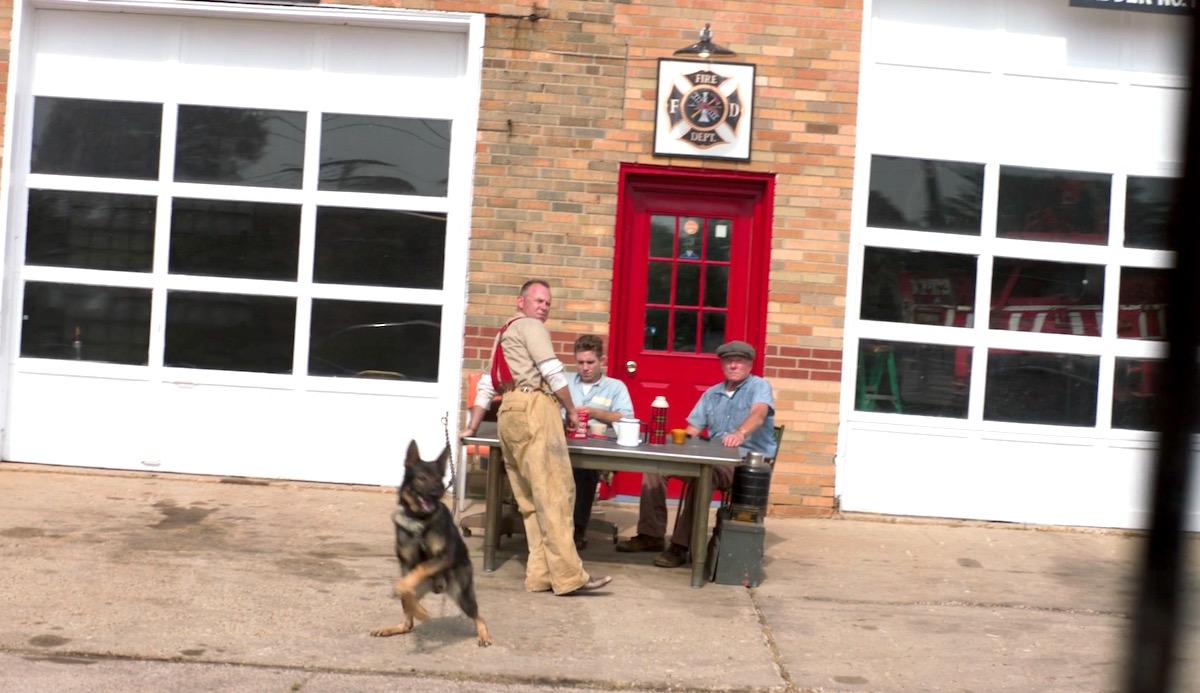
For, once we are on the other side of that brilliant Baldwin montage, we are in full-on genre territory: We are, to put it simply, in a horror movie, or (more accurately) in a series of horror movies. And I will confess that, on first viewing, I found the second half of "Sundown" slightly less interesting than the first: more viscerally exciting, to be sure, but less intellectually and narratively exciting. And that reaction is something I want to interrogate a little bit here.
I do not mean for a moment that is is badly done: In fact, it's quite clever and effective. It begins when Tic, Leti, and George arrive at the small town of Simmonsville, to eat at a diner that George has been told is friendly to black travelers. (Part of George's purpose on this trip is to check out and confirm entries in his Safe Negro Travel: "A bad tip in the guidebook gets someone killed," he says.) And the moment they roll down the nearly empty Main Street, we know this is not a good place. Driving past the fire station, the hostile glares of the white men seated outside—and the overly-excited reaction of their German Shepherd—instantly evoke the television images of fire hoses and dogs being set on black civil rights activists just a few years later. And as they enter the diner—which is not named, and does not look, like the one George had been told to expect—the deer-in-the-headlights alarm on the faces of the young white counterman (Michael Kurowski) and sole white customer (Vincent Teninty) tells us most of what we need to know about how this is going to go.

What I find fascinating about this is how it repurposes familiar horror tropes to original and specific purposes. It may feel—to a white viewer, that is—slightly exaggerated, even broadly satirical. (It takes less than two minutes after sitting down for Tic to notice the paint job—"Remind me why the White House is white?"—and realize that the previous, black-friendly owners had been burned out. And, less than 30 seconds after that, the three visitors are fleeing for their lives, pursued by a siren-blaring firetruck and rednecks with rifles.) This is, after all, the first visit to a white business that we see them make outside of the montage, and it almost instantly becomes a nightmare.
It is, then, our first realization of how Lovecraft Country plans to use the horror genre to depict the horrors of systemic racism. And it does feel—in comparison to the earlier, more narratively sophisticated sequences—a little simplistic, even a little obvious. But then that, surely, is the point? It reminds us of B-picture horror movies—Children of the Corn, for example—in which travelers wander off the highway into a strange small town, and almost instantly find themselves in a nightmare scenario. The reception Tic, Leti, and George receive at the diner also reminds us, perhaps, of scenes in films like An American Werewolf in London, where the two American tourists enter a rural English pub, and are met with distrustful stares, the atmosphere instantly turning paranoid and menacing. These are standard horror motifs used to depict—in ways that are perhaps condensed, but not really exaggerated—the dangers of these sundown towns, and how it feels, in general, to be a Black person entering an exclusive white space.
And—to interrogate my own reactions a step further—at first I found myself resisting, a little, the cardboard inhumanity of the white antagonists: the instant lynch-mob in Simmonsville, the blatantly homicidal police officers in Devon County later, et cetera. Again, my resistance came not so much from a defensive place—I don't think—as a creative one: It seemed like overly simplistic storytelling, lacking a little nuance and complexity. (I have not read any reviews of Lovecraft Country yet, but I suspect that many of the lackluster ones may approach their criticisms from this direction.) What, I wondered, would Misha Green tell us about racism that we didn't already know?
For myself, however, it took only a moment of questioning that reaction—of interrogating my own deeply held assumptions—for the validity of the criticism to fall apart. First of all, Hollywood is stuffed to its shameful rafters with sympathetic, humanizing, "nuanced" examinations of white racists: That is, quite honestly, the true purpose of the vast majority of movies and TV shows that purport to be about racism. (Recent Oscars given to such films as Green Book and Three Billboards Outside Ebbing, Missouri testify to how much Hollywood loves to "humanize" racists.) That is not the project here, and it shouldn't be the project anywhere. (What, honestly, is there to say about the psychology of white racists that has not been said before?)
Secondly, for a white viewer like myself to feel a momentary twinge of protest at seeing every white person caricatured as a cardboard villain is for us to experience a tiny fraction of a BIPOC viewer's experience since the invention of the movie camera, or indeed of a BIPOC reader (like Tic) attempting to enjoy the works of H.P. Lovecraft or Edgar Rice Burroughs. (To even attempt a catalog of demonized people of color seems unnecessary in the extreme: How much humanity, for example, was afforded to Native Americans in all those Hollywood westerns of the '40s and '50s? And we don't need to go so far back: My wife and I recently revisited Brian De Palma's 1980 thriller Dressed to Kill, a film which—in the middle of what was already a shamefully transphobic plot—finds room for a completely random scene of Black youths threatening to rape and murder the white protagonist who has bumped into them on a subway platform. These Black figures are not presented as human, let alone as characters: They are stereotyped and objectified as a purely environmental threat.)
This sort of incidental, almost casual expression of irrational white fears has been commonplace in movies told from a white perspective forever—which is to say, in nearly all the movies. So there seems nothing out of line about Green's repurposing those tropes to depict the entirely rational fears of people of color here. (In fact, it's goddamned refreshing.)
"I don't think we want to be out here after dark."
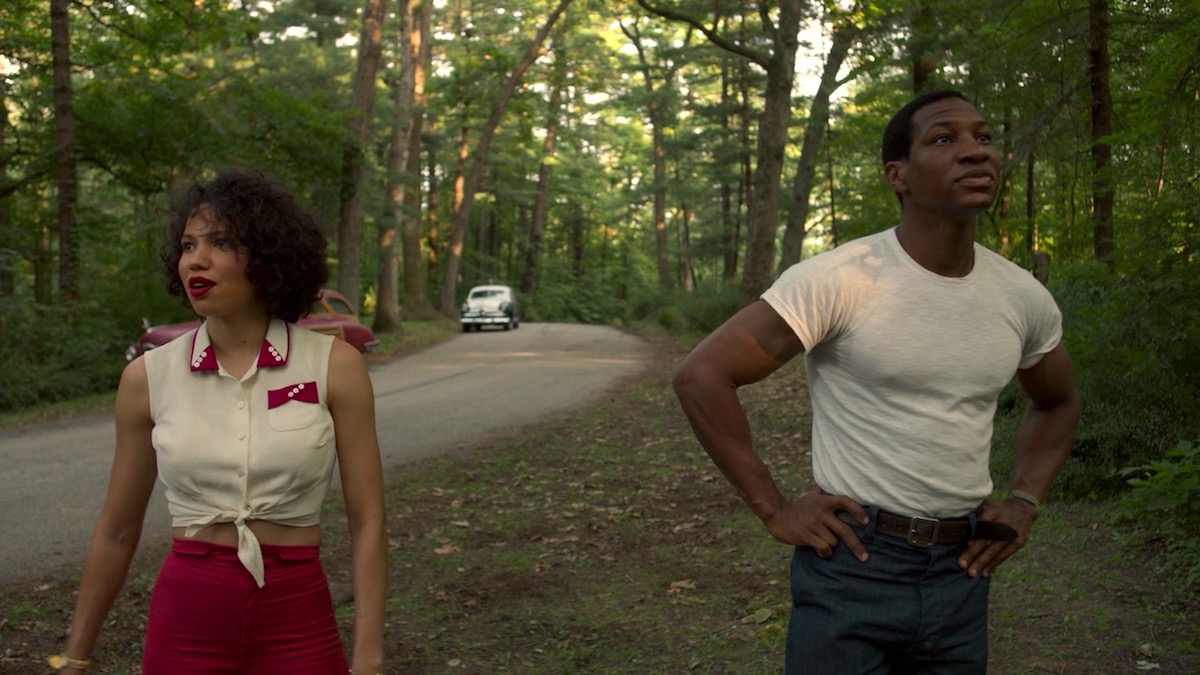
And it works. In cinematic language, the race out of Simmonsville is not quite in a horror-movie tone: It feels more like an exciting heist movie escape or an action-movie chase. (In fact, it is depicted as such an expected, commonplace occurrence that our heroes laugh about it over dinner with Leti's brother Marvin [Demetrius Grosse].) But the real horror begins in Devon County, with the arrival of Sheriff Eunice Hunt (Jamie Harris).
It should not even require saying at this point that, even today, every encounter with a police officer feels like a life-or-death scenario for people of color—because it is. So when George, Tic, and Leti stop on a country road, and we see that police cruiser slowly pulling up behind them, it is as instantly chilling as the appearance of any other movie monster. (Demange shoots the scene, too, like a classic horror set-up: Tic and Leti have their backs to the road, relaxed, so we see the danger coming long before they do. The sheriff's car is the shark-fin in Jaws, the shadow on the curtain in Psycho, the silently approaching figure of Michael Meyers in Halloween.) And these comparisons are completely apt, because we have already been told that Sheriff Hunt has a thick complaint file with the NAACP, and is almost certainly responsible for a lot of "missing persons" reports: He is, in no uncertain terms, a serial-killer.
And he toys with his victims like a B-movie serial killer. The tensest, most harrowing two minutes in "Sundown"—and perhaps the purest distillation of Misha Green's project here—is the brilliant sequence in which Hunt follows them out of his "sundown county." It is, once again, not so much an exaggeration of the dangers—for they cannot be exaggerated—as a condensation of those dangers into horror movie conventions.
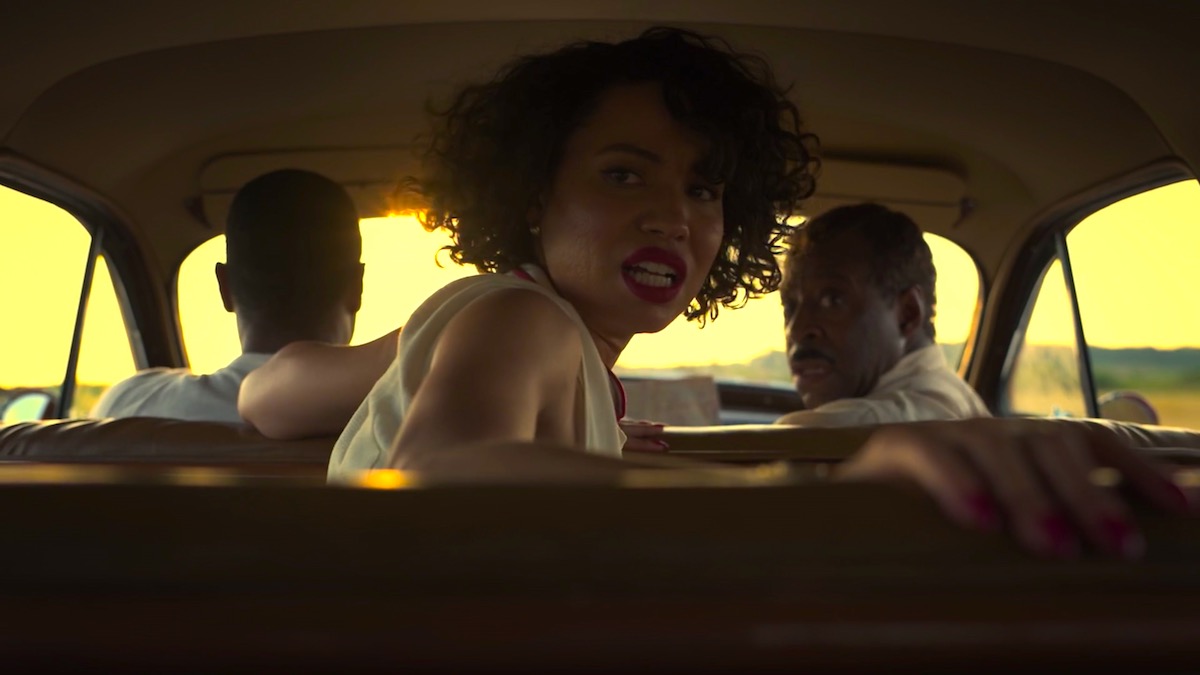
The entire scenario—though absolutely rooted in reality—takes on the air of a serial-killer's game, a sort of Saw-type challenge with its own sadistic and arbitrary rules of survival. (There is, after all, little reason Hunt could not simply kill them where they stand, as this is what he clearly wants and intends to do. So his more elaborate cruelty here plays into horror movie conventions, certainly. But I also think that, by doing so, it makes larger points: about the arbitrary, no-win rules that white society has institutionalized to justify its own injustices, and about the sadistic pleasure that fuels the enforcement of those rules.)
Tic savvily avoids the sheriff's first trap, by thinking to ask Sheriff Hunt permission to make the U-turn he must make to comply. (Hunt seems amused that Tic was smart enough to think of that, and so forces him to beg for the privilege in self-degrading terms.) Then they must drive across the county border, three kilometers away, before the exact moment the sun sets. But they cannot speed, for that would be another transgression against the rules, resulting in a fatal forfeiture of the game. And, finally, Hunt provides an additional obstacle himself, tailgating them and occasionally ramming into their car like the homicidal truck driver in Steven Spielberg's Duel.
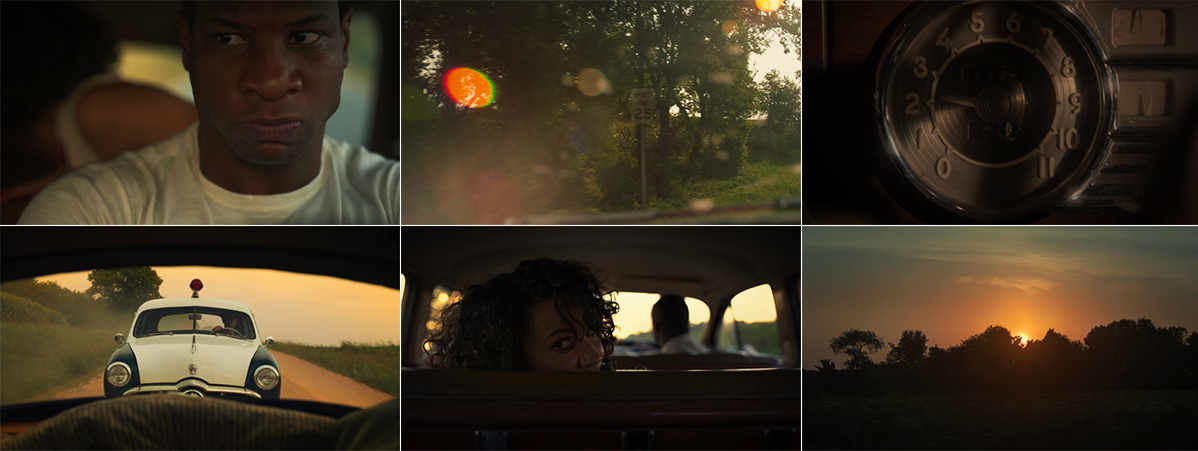
And Demange executes this sequence brilliantly, using every trick in the suspense-director's toolbox. The editing in this scene (by Marta Evry and Chris Wyatt) is a lesson in building unbearable tension in a very short amount of time, as we cut quickly between external shots of the cars, close-ups of Tic's tense face, POV shots of the Speed Limit sign and the speedometer, Leti crouched in the back seat with the gun, her POV shot of the sheriff's car barreling down on top of them, and repeated shots of the rapidly setting sun that means their doom. It's a masterful sequence.
And, of course, it's all for naught. As many people have observed, horror is structurally akin to comedy—reliant on set-ups that build to a surprise—and the chase sequence here turns out to be one long set-up. They make it over the border just in the nick of time, but the release of tension is a short-lived feint before the delivery of a much crueler punchline: Just over the first hill in the adjacent county, they run into a roadblock and four more cops.
Because the game is rigged. The game is always rigged.
"What happens when you get bit by a vampire?"
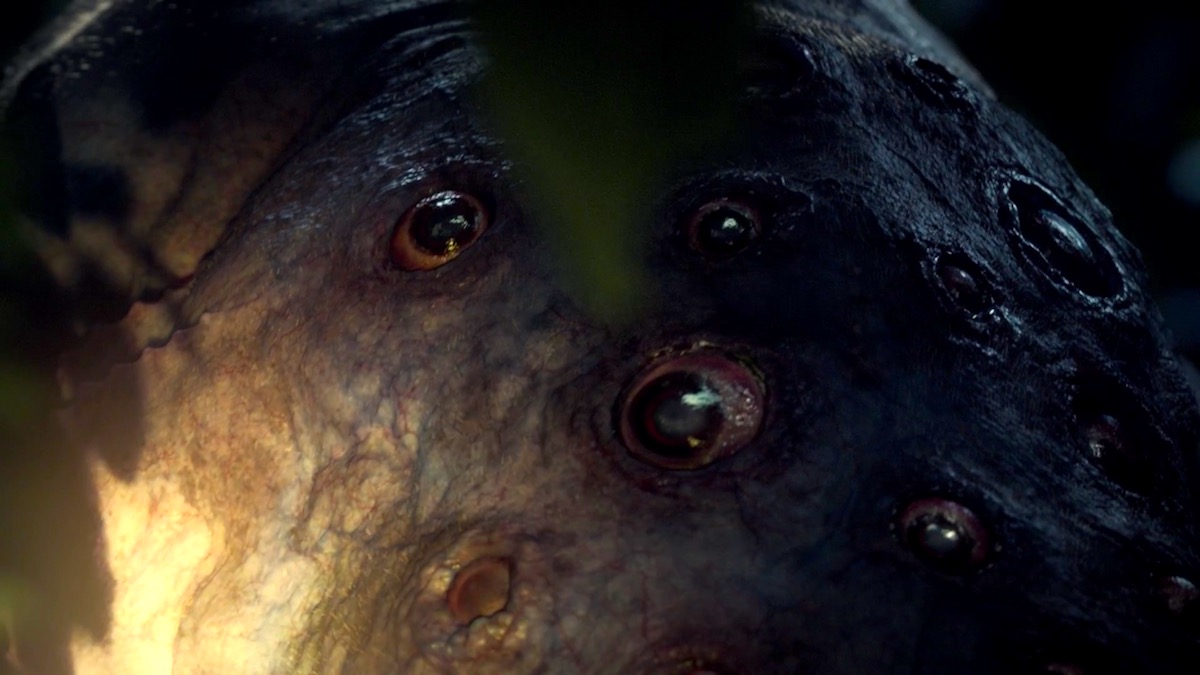
In the final act of "Sundown," all illusions are stripped away, and everything that was (just barely) subtext rises to the surface as text. On the road, in the town, in the light of day, the danger were real and pervasive but they were checked, slightly, by the tiniest veneer of civilization, of rules, of law. (Follow the rules and you might survive: That was the system in the daylight.) Here, however, in the woods, and in the dark—away from prying eyes—there is not even that thin hope. The cops talk as if this is still about law enforcement—they "question" the travelers about recent robberies—but neither they nor their victims have any delusions about the fact that this is a lynching about to happen.
This is not subtle racism, or elaborate racism, or racism cloaked in the coverings of law and order: This is open, raw, unvarnished hatred and evil, existing for its own sake and taking its own pleasure. It is a pure expression of that original, primordial sin, and so that sin awakens into pure monstrosity. The Lovecraftian evil at the heart of America—which is always present—steps out of the shadows to show its true face, milky white and ravenous, prepared (as it always is) to consume oppressor and oppressed alike.
Lovecraft Country has moved through so many horror tropes in this first episode that one wonders what it will have left for the next nine entries. In this final act we get a little bit of everything. Running through the woods pursued by monsters calls back to any number of classic scenarios, from The Wolf Man to Friday the 13th. The cabin in the woods where they take shelter is another standard motif: There's a lot of Evil Dead in the mix (including the danger of people inside suddenly turning into monsters), and—particularly with the distrustful racial mix within—a great deal of Night of the Living Dead. George himself quotes from Dracula: "Listen to them, the children of the night. What music they make!" And later he will observe—as the bitten cops begin to turn—"What happens when you get bit by a vampire?"
There are some very well executed horror scenes here. Leti's mad dash through the woods to get the car is both an effective horror sequence and a refreshing reversal of horror movie gender roles. (At the beginning of the episode, George told his wife Hippolyta [Aunjanue Ellis] that the road was too dangerous for a woman. Here, Leti proves she's at least as capable as the men, and Tic yields the "hero" role to her confidently. "I'm not scared because fear's not going to save us right now," he tells her. You are.")
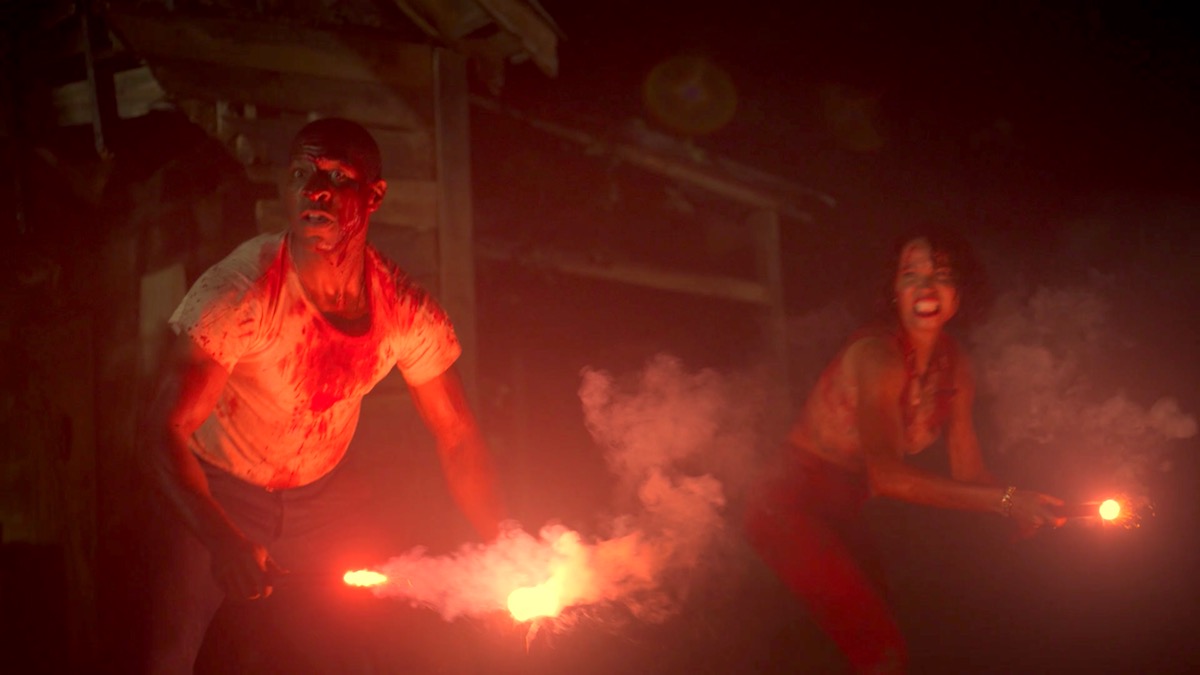
At the same time, however, this was the section of "Sundown" I found least interesting. The two big names joining Misha Green as executive producers of Lovecraft Country are Jordan Peele and J.J. Abrams, and this sequence feels a little more like Abrams than either Green or Peele. It is not bad, but it is a little too familiar, like a comforting pastiche of horror tropes rather than a clever repurposing of them. Yes, there are simple but poignant metaphors at work here: The racist cops are the real monsters, and so they become the monsters, in scenes that feel more like a revelation of their true faces than any transformation. And the entire metaphor of "the light hurts them" can obviously be read as a statement on the need to drag injustice into the light where we can see it clearly. (I particularly love the brief moment when Leti uses the flash of her camera to scare off a Sloggoth. From Gordon Parks to Twitter activists, there is no greater weapon against injustice than the camera.)
But in general this final act felt like a too-standard and slightly too-sticky dessert after a surprising and nourishing meal. You've sat through James Baldwin, the episode seems to be saying, but don't worry, we're also going to have big scary monsters ripping people's arms off.
Which is the tricky part of shows like Lovecraft Country: They're a balancing act, a delicately assembled piece of music in major and minor themes. I did not end up writing about the series finale of Watchmen, but I felt like it got that balance wrong in its ultimate act, abandoning too much of its nuanced social and historical commentary in its rush to tie up its complicated sci-fi plot. But then, I was in it for the nuanced social and historical commentary, and I thought the silly plot was just the wrapping on the gift. (Others—for whom those priorities were reversed—were no doubt more satisfied with the conclusion than I was.) Ultimately, I found myself asking which had been the point? Did Lindelof set off primarily to tell a good comic book story, and add the exploration of race to give it weight? Or did he set out to challenge America's received narratives about race, using comic book stories as the vehicle? Which was the structure, and which was the decoration?
I find myself asking that same question about Lovecraft Country. Is it primarily a horror-adventure series lent weight by reframing systemic racism in horror tropes? Or is it primarily an examination of systemic racism made exciting through the use of horror conventions? But—based on this strong opening episode, and based on Misha Green's past work—I remain wildly optimistic. Either way, there's enough amazing stuff happening here that I'm in for wherever Lovecraft Country leads.
Additional Thoughts and Favorite Bits
- Welcome to my ongoing coverage of Lovecraft Country. My regular readers know more or less what to expect from me, but if you've just discovered The Unaffiliated Critic for the first time, a few words of explanation may be in order. I don't write "recaps," and I don't really think of these pieces as "reviews." What they really are is a way for me to process an episode of television out loud. As such, they tend to be very long, and I like to take my time with them, so it's very rare that they'll go up immediately after an episode airs. The Tuesday after an episode airs will always be my goal, but Wednesday or Thursday is likely, and later in the week is hardly unheard of around here. Please bear with me, and you can subscribe to the site below, or follow me on Twitter, so you don't miss anything.
- I should also mention here—in case it needs mentioning—that I am very self-conscious about being a white guy writing about this show. It's an ongoing problem with being a one-man operation: I know I am not necessarily the best person to be writing about some shows, but either I fumble through them as best I can in good faith, or I don't cover them at all. As I've done in this review, I'm going to try to approach Lovecraft Country with an active awareness of my own privileged perspective, my own assumptions, and my own limitations. I'll probably get some things wrong, I'll probably miss some things completely, and I'll try to educate myself as much as possible along the way. And I would love to hear feedback from my readers.
- I realize at the end of this post that I have done very little discussion of the characters, and this is because that's an area in which I want to see more before I say anything one way or another. "Sundown" had a lot of stuff to get through, and it did so brilliantly for the most part, but all three major characters we've met (so far) seem a little thin. The actors are all fantastic, but we simply don't know much about any of the characters yet beyond a few cryptic snippets. (Tic's relationship with his father, and Leti's with her late mother, are obviously going to be important. George, I think, knows more about the central mystery than he is admitting. And who is the woman Tic calls in Korea? Mysteries yet to be revealed.) I hope the show finds some more quiet moments between monster attacks (human and otherwise) to flesh out these characters a little more.
- I hope we see more of Dee, whose homemade comic-books starring black heroes echo the show's overall project of repurposing pulp fiction tropes.
- Even in a post this long, there are way, way too many things to unpack in this episode than I found space for. One significant throwaway bit is that George mentions having his knees smashed up "outside of Anna." He is referring to Anna, Illinois, a small town in the southern part of the state, just a few miles west of Missouri and north of Kentucky. One of America's most infamous "sundown towns" for over a century—the local "joke" is that ANNA stands for "Ain't No N–––––s Allowed"—it has been the site of horrific incidents of white supremacist violence, and still maintains a population that is almost 96 percent white. (You can read more about Anna here.)
- Who are those mysterious (and preternaturally Aryan) people who keep popping up? What was the sound that drove away the Sloggoths? I guess we'll find out. Hope to see you back here next week.

1 thought on “MISHA GREEN WELCOMES US TO <I>LOVECRAFT COUNTRY</I>, WHERE ONLY MOST OF THE HORRORS ARE HUMAN”
The race to get to the county line was terror-inducing even as it was familiar horror-movie fare – and for this white viewer, educative: in the world of white supremacist culture, this is what the terror must feel like. Thank you for this detailed analysis – I'm looking forward to the series (the show as well as your commentaries).